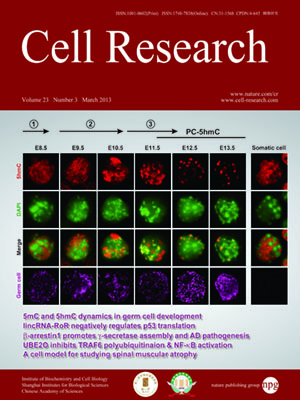
Volume 23, No 3, Mar 2013
ISSN: 1001-0602
EISSN: 1748-7838 2018
impact factor 17.848*
(Clarivate Analytics, 2019)
Volume 23 Issue 3, March 2013: 378-393
ORIGINAL ARTICLES
Recapitulation of spinal motor neuron-specific disease phenotypes in a human cell model of spinal muscular atrophy
Zhi-Bo Wang1, Xiaoqing Zhang2 and Xue-Jun Li1,3
1Department of Neuroscience, the University of Connecticut Health Center, 263 Farmington Avenue, Farmington, CT 06030-3401, USA
2Department of Regenerative Medicine, Tongji University School of Medicine, Shanghai 200092, China
3Stem Cell Institute, the University of Connecticut Health Center, Farmington, CT 06030, USA
Correspondence: Xue-Jun Li,(xjli@uchc.edu)
Establishing human cell models of spinal muscular atrophy (SMA) to mimic motor neuron-specific phenotypes holds the key to understanding the pathogenesis of this devastating disease. Here, we developed a closely representative cell model of SMA by knocking down the disease-determining gene, survival motor neuron (SMN), in human embryonic stem cells (hESCs). Our study with this cell model demonstrated that knocking down of SMN does not interfere with neural induction or the initial specification of spinal motor neurons. Notably, the axonal outgrowth of spinal motor neurons was significantly impaired and these disease-mimicking neurons subsequently degenerated. Furthermore, these disease phenotypes were caused by SMN-full length (SMN-FL) but not SMN-Δ7 (lacking exon 7) knockdown, and were specific to spinal motor neurons. Restoring the expression of SMN-FL completely ameliorated all of the disease phenotypes, including specific axonal defects and motor neuron loss. Finally, knockdown of SMN-FL led to excessive mitochondrial oxidative stress in human motor neuron progenitors. The involvement of oxidative stress in the degeneration of spinal motor neurons in the SMA cell model was further confirmed by the administration of N-acetylcysteine, a potent antioxidant, which prevented disease-related apoptosis and subsequent motor neuron death. Thus, we report here the successful establishment of an hESC-based SMA model, which exhibits disease gene isoform specificity, cell type specificity, and phenotype reversibility. Our model provides a unique paradigm for studying how motor neurons specifically degenerate and highlights the potential importance of antioxidants for the treatment of SMA.
Cell Research (2013) 23:378–393; doi:10.1038/cr.2012.166; published online 4 December 2012
FULL TEXT | PDF
Browse 2321


